For us enthusiasts, it’s nearly impossible to think of a performance car without BMW’s iconic M3 coming to mind. Throughout just over three decades of immense success globally, the M3 has been offered as a coupé, a convertible, and even a sedan. About five years ago when the current “F80” M3 was introduced, the line split into two distinct models, the M3 and the M4. Two-door variants became the M4, while the sedan retained the M3 name. Thankfully these two M cars have yet to receive the “Gran Coupe” or “Gran Turismo” dilution, and have maintained the personality that made them special in the first place.
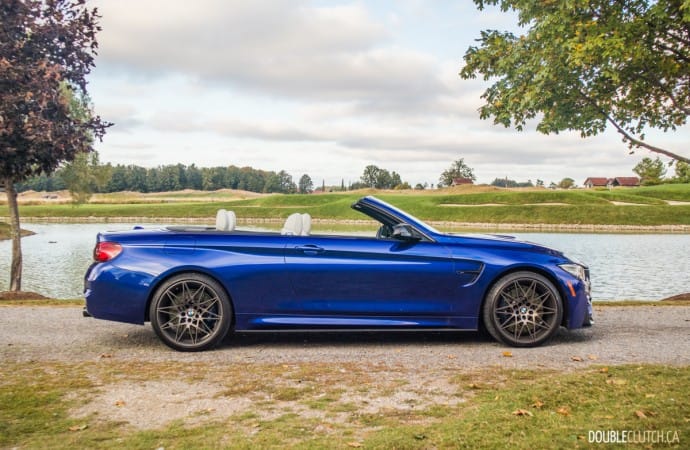
Nearing the end of its model cycle run, we jumped into this 2020 BMW M4 Cabriolet, complete with the Competition Package and every other available option, to re-evaluate a favourite and understand just where it stacks up against more modern and current rivals. The M4’s Cabriolet configuration consists of a power retractable hardtop, and comes at an $8,650 premium over the coupé. The M4 Cabriolet also starts at just over $10,000 more than the M3 sedan (reviewed here).
Painted in a stunning San Marino Blue (an additional $895), the M4 Cabriolet is a real stunner. The 20-inch M Light Alloy wheels in Style 666M look gorgeous, and while the proportions of the current M4 look slightly bulbous in most colours, it looks bang-on here. This model is also equipped with some additional visuals including a carbon-fiber rear diffuser, black side skirts, and additional carbon-fiber bits all around. Full LED headlights and the mid-cycle (LCI) update for 2017 brought more modern lighting all around the 4-series.
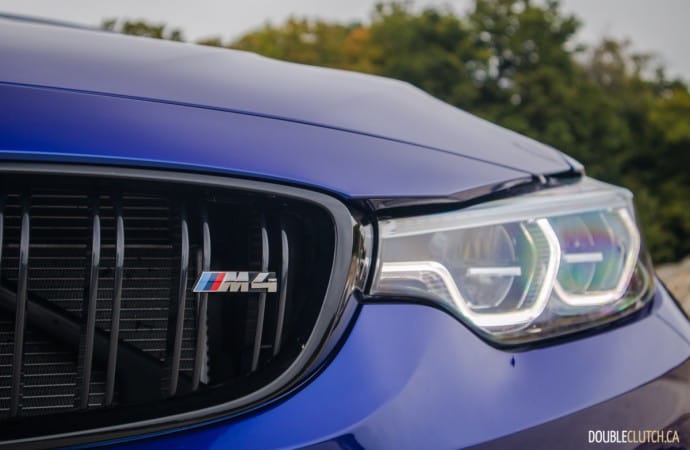
While the M4 Cabriolet isn’t skinny at 4,125 pounds, the powertrain makes it drive a lot lighter than it is. A 3.0-liter twin-turbocharged inline six-cylinder codenamed the “S55” lives under the long hood. Regular models get 425 horsepower, but the Competition Package adds 19 more for a total of 444 from 5,500 to 7,300RPM, and torque remains unchanged at 406 lb-ft. from 1,850 to 5,500RPM. This motor is a fantastic one, with crisp throttle response and minimal turbo lag; it also will make the 0-100km/h sprint in a snappy 4.4 seconds.
It’s fast and feels damned good while doing it, and the M4 remains true to its heritage as an M performance car with sharp handling as well. The transition to electrically assisted power steering meant some analog feel has disappeared for the current generation. Regardless, the M4 Cabrio turns in quickly and does bring some communication to the driver’s fingertips. It responds with minimal fuss and the rear-drive setup means the M4 is eager to oversteer if asked to, with the ability to fully defeat all Dynamic Stability Control systems at the touch of a button.
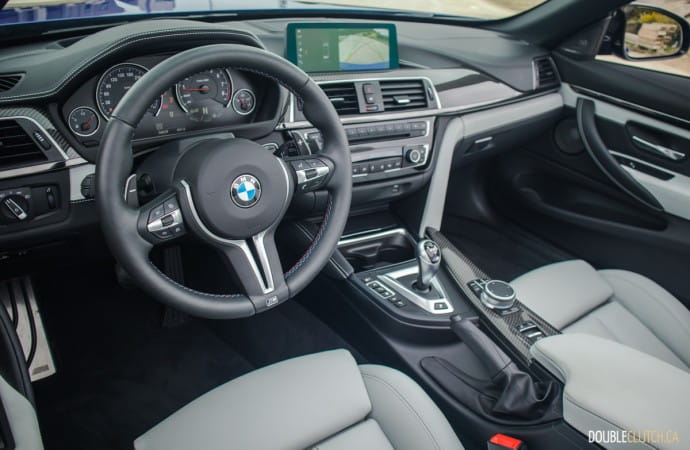
The seven-speed dual-clutch gearbox is a spectacular one in its sportiest settings, with quick and aggressive shifts. It has a launch control function that can make for the optimal takeoff, should you desire. In its “standard” setting and in dense traffic situations however, this M DCT is a bucking bronco, unsure of where it wants to be and often making for jerky and confused shift behaviour. If you’re able to row your own gears, the six-speed manual is the obvious choice here. We also wager that three-pedal variants will hold their value better in the future; just look at how early SMG cars from the mid-2000s are aging.
The fancy mechanism and parts for the power-folding roof carry a weight penalty of roughly 550 pounds over the M4 Coupé, though structural rigidity doesn’t feel nearly as compromised as in other open-top sports cars. The Ford Mustang Convertible (reviewed here) is a particularly bad offender in this regard. The M4 feels rock solid regardless of roof position, though minimal cowl shake is evident with the top down. The frameless windows tend to shake a little bit when they’re up with the top down, especially over road imperfections. This hardtop doesn’t rattle as much as those of the past, and also means drivers can enjoy their convertible year round even in colder climates. The M4 Cab is quiet and serene at highway speeds in its most comfortable setting, and devours the miles effortlessly.
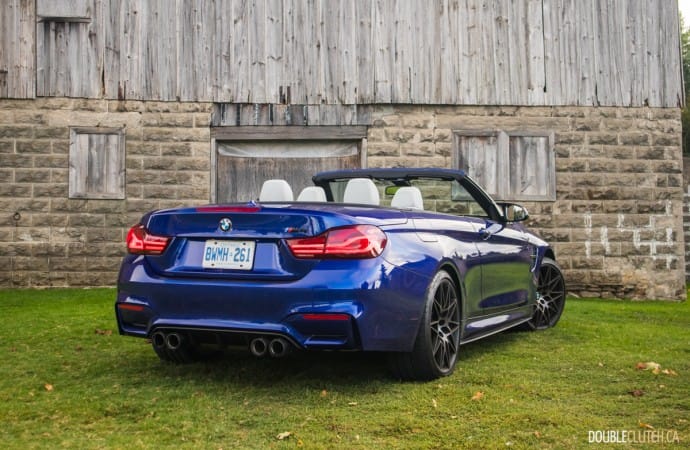
Cargo space in the 4-series Cabriolet in general is at a premium, with a maximum capacity of 370-liters with the top up. Opt to roll with the top down and the wind in your hair, and this number goes down to 220-liters. Nothing more than an oversized backpack will fit, however the rear seats do fold down to hold longer items such as golf clubs (if the top is up). However, inside the car it’s a different story – the seats are plenty comfortable, well bolstered and there’s ample room for four to fit reasonably well.
After having driven the latest 3-series (reviewed here) and its larger counterparts, the M4’s interior layout immediately feels one generation out of date. It’s still a fairly good design, with major controls for the climate and stereo having physical buttons and knobs. This model is also running the previous generation of iDrive, which means while it does have wireless Apple CarPlay, it doesn’t have a touchscreen and is generally not as simple to use as the latest application.

Adding to the $89,000 base price of the M4 Cabriolet, our tester was equipped with the “Ultimate Package”, which costs an eye-watering $26,000. This package basically comes with everything you can possibly get, which starts with LED headlights and blind spot detection, and adds all of the M Performance and Competition bits as well. Other inclusions here are a heads-up display, wireless charging, surround view camera, adaptive M suspension and more. This package is available with both six-speed manual and dual-clutch automatic transmissions, and in the case of our test vehicle, brought the total sticker price to about $119,000.
Another point of controversy on the M4 is the titanium exhaust; while some members of our team (myself included) found it intoxicating and lovely, others found it raspy and irritating. Regardless of this controversy, the M4 Cabriolet has stiff competition at the price point. While it technically goes up against models like the Mercedes-AMG C 63 S, rivals are broader than initially meets the eye. The Porsche 911 Carrera (reviewed here) is in the same price bracket, and so are high-horsepower American rivals like the Chevrolet Corvette Z06 (reviewed here).
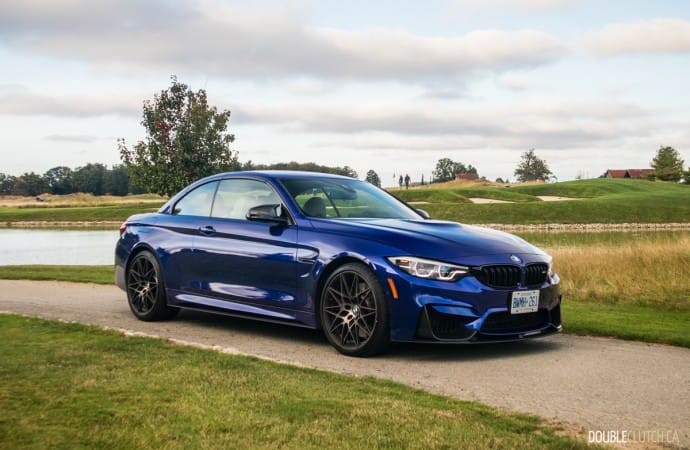
Should you buy the M4 in fixed-roof form or the Cabriolet tested here? Well, that’s a subjective one – the coupé is absolutely the sharper, lighter example. Those who live in an area where the road quality is smooth as glass won’t see a difference, but the M4 Cabriolet does exhibit some rattles and squeaks over rougher pavement and potholes. That said, this is only a part of the personality of any retractable-hardtop convertible and true to its charm. It’s quickly outweighed by the confident sound of the S55 engine and titanium exhaust, and nothing can beat the feeling of that soundtrack with the wind through your hair on a cool fall evening.
Advertisement
Vehicle Specs
Segment
Engine Size
Horsepower (at RPM)
Torque (lb-ft.)
Fuel Efficiency (L/100km, City/Highway/Combined)
Observed Fuel Efficiency (L/100km)
Cargo Capacity (in L)
Base Price (CAD)
As-Tested Price (CAD)
The DoubleClutch.ca Podcast
Advertisement
Advertisement
Advertisement

